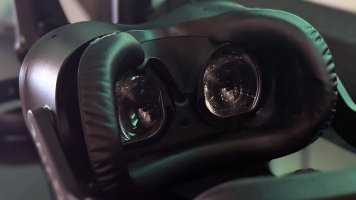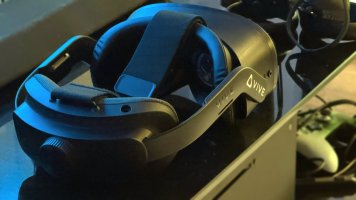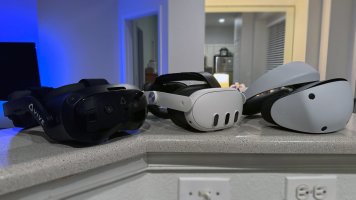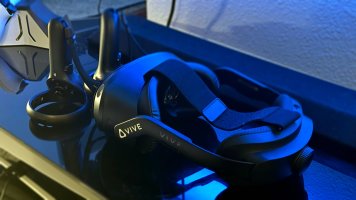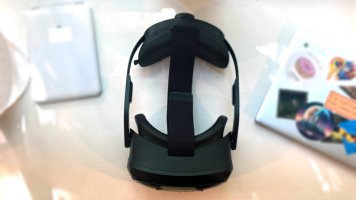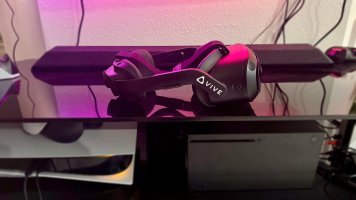General Information
The headset's feature set is undeniably robust. It boasts a combined 5K resolution (2,448 x 2,448 pixels per eye) delivered through dual Fresnel lenses, providing an expansive near-120-degree horizontal field of view at 90hz – with plans for a 120hz option in PC streaming mode through a future update. The device incorporates two semicircular arrays of eye-tracking cameras around both lenses, enabling motorized auto-IPD adjustment and foveated rendering. Four inside-out tracking cameras deliver precise hand and controller tracking, though controller performance can be inconsistent at times. The headset's capabilities extend to facial tracking and compatibility with external trackers, allowing users to create realistic avatar movements and facial expressions in social VR applications like VRChat.
Given these capabilities, the Vive Focus Vision edges out the PlayStation VR2 as my preferred dedicated SteamVR headset, though the margin is admittedly slim. My recent gaming sessions with titles like Blade & Sorcery, H3VR, Pavlov VR, and Half-Life: Alyx have demonstrated its prowess, though its performance largely mirrors the HTC Vive Focus 3, with the notable exception of its groundbreaking DisplayPort compatibility – a first for the Vive Focus lineup. The standalone operating system offers straightforward usability, while the boundary-setting and room-scanning features perform adequately, supported by quality full-color passthrough and an integrated depth sensor. However, Viveport's limited game library, particularly in mixed reality titles, suggests HTC's mixed reality capabilities were implemented more for specification purposes than practical application. The $999.99 price point represents better value than its enterprise-focused predecessor's $1,300 tag, though it's clear the target audience remains PC VR enthusiasts and location-based entertainment venues, who will particularly appreciate features like the convenient hot-swappable battery and the magnetically-attached, easily maintainable facial interface.
HTC Vive Focus Vision – Design and Features
The HTC Vive Focus Vision showcases a sophisticated all-black aesthetic that successfully balances comfort with visual appeal. The glossy front panel exhibits a distinctive cyberpunk-inspired design, while its versatile standalone capabilities position it as a comprehensive spatial computing solution – functioning much like a VR Swiss Army Knife – making it an attractive alternative for users seeking options beyond Meta and Apple ecosystems.
The device's impressive array of technology includes integrated eye-tracking cameras, dual 16MP full-color passthrough cameras, a depth sensor for mixed-reality applications, and an IR flood light enabling low-light hand tracking – all marking significant improvements over the 2021 Vive Focus 3. Its groundbreaking DisplayPort-over-USB-C capability sets it apart in the Focus series. While both models utilize the aging Snapdragon XR2 Gen 1 platform (shared with the Meta Quest 2), the Vision compensates with enhanced performance through increased RAM, jumping from 8GB to 12GB.
A standout feature of the Vive Focus Vision's design is its integration with the Vive Focus ecosystem, particularly evident in its universal 7000mAh hot-swappable battery system. The term "universal" is especially apt, as this battery maintains compatibility with previous Vive Focus models. Notably, it can be charged independently from the headset using a 30W AC adapter, achieving approximately 50% charge in 35-45 minutes during my testing. When removing the battery from its magnetic rear housing, users have a generous 20-minute window of internal battery life to complete the swap – after which, gameplay continues seamlessly. For PC-tethered usage, the battery life extends significantly to around seven hours. This feature proves invaluable for VR arcades and commercial establishments serving multiple users daily, while also ensuring extended usability for individual users.
The device's comfort-focused design is evident in its magnetic attachment system for both the facial interface and rear gasket (housing the hot-swappable battery). Both components offer generous pleather padding for the face and posterior head support, enabling comfortable extended wear sessions. While the Focus Vision does carry more weight than the Quest 3 during intense physical activities, the easily cleanable and replaceable nature of these components offers practical advantages.
The adjustable head strap deserves particular praise for its exceptional comfort and stability. Unlike the Quest 3 and Quest 3S's standard Y-style strap, it maintains its position effectively during vigorous movement. The intuitive design features a convenient release button on the rear, facilitating quick strap adjustments and knob configurations. The Focus Vision also incorporates an impressive auto-IPD function within its settings menu, utilizing its eye-tracking capabilities to rapidly adjust the display's interpupillary distance between 57 and 72 mm in mere seconds.
The facial interface design stands out for its generous spatial accommodation, maintaining consistent comfort without requiring frequent adjustments. Notably, it leaves minimal facial impression marks even after extended use sessions – a common issue with other VR headsets. The included glasses spacer enhances compatibility for spectacle wearers, working effectively alongside the pre-installed light bleed guard that sits discreetly beneath the lenses to eliminate external light interference. This comprehensive approach to user comfort surpasses even the highly regarded PS VR2, which speaks volumes about the Focus Vision's thoughtful design considerations.
However, the Focus Vision's visor-mounted fan presents a notable drawback – its substantial size and considerable noise level become apparent even during basic operations like accessing the headset's internal browser. The noise can be particularly distracting, reminiscent of a struggling PS4's cooling system, which isn't particularly reassuring when the source is mounted directly on one's face.
The headset's connectivity options are thoughtfully implemented, featuring dual USB-C 3.2 ports – one conveniently positioned on the right side adjacent to the Aux-In jack, and another discreetly housed in the visor's front section beneath a removable panel. The latter port, according to community feedback, primarily serves to accommodate USB-C accessories such as external facial and body tracking devices, though these remained untested during the review period.
This port configuration does present a minor inconvenience – the right-side USB-C connection can interfere with user movement when cables are attached. Furthermore, relying solely on wireless connectivity proves somewhat problematic, as the headset's Wi-Fi 6E capabilities struggle to maintain a stable SteamVR connection via Vive Hub, resulting in noticeable artifacts and compression issues. This persisted even with substantial upload speeds of approximately 200MB/s – a bandwidth that typically ensures smooth performance with Virtual Desktop on competing devices like the Quest 3 and 3S.
A clever design element is the microSD slot, supporting storage expansion up to 2TB, discretely positioned behind the removable facial interface. However, given the 128GB of built-in storage and the relatively modest selection of apps and games available through the official Viveport store, additional storage felt unnecessary, especially with access to a VR-ready gaming PC.
The audio system comprises two built-in directional 3D speakers positioned optimally near the ears when the headset is properly fitted. This feature notably outperforms other contemporary PC VR headsets, the PS VR2, and even the Quest 3. The audio quality consistently delivers crystal-clear sound (when the fan operates at normal levels), with particularly impressive spatial audio capabilities. The surround sound performance is so convincing that Half-Life's alien encounters feel startlingly realistic within one's physical space.
The device includes dual microphones enhanced by integrated echo-cancellation technology accessible through the headset's settings. Once properly configured in Windows, they deliver excellent audio quality. Similar to the recent Quest 3S, the headset features a conveniently placed volume control on its bottom edge, complemented by an action button on the left side that efficiently toggles between immersive mode and full-color passthrough with a couple of quick taps.
HTC Vive Focus Vision – Setup and Controllers
The setup process for the HTC Vive Focus Vision follows a familiar path similar to other VR headsets in the market. Users must create an HTC account and install the Vive Manager mobile app, reminiscent of Meta's Quest headset initialization process. The basic setup is relatively straightforward, requiring approximately 25-30 minutes before users can access their SteamVR library. However, utilizing the Vive Wired Streaming Kit for direct PC or Mac connection demands additional configuration time of 15-20 minutes, whether connecting through USB-C or the Focus Vision's proprietary DisplayPort-to-USB-C adapter.
The PC-side setup proves equally user-friendly, with Vive Hub installation requiring a simple download from HTC's official website. Post-installation, the software integrates smoothly with SteamVR after minor adjustments. Users need to install additional components including the Vive Streaming service, Vive Hub app, and Vive Desk service – the latter being essential for digital workspace functionality. For optimal PC VR gaming performance, disabling Hardware-Accelerated GPU Scheduling is recommended.
The controllers, unfortunately, represent one of the Focus Vision's significant weaknesses. While they incorporate a standard dual-stick layout compatible with modern Touch Plus and Sense Controllers, their excessive size and unwieldy design often interfere with gameplay mechanics. This becomes particularly problematic in games requiring precise movements, such as reloading weapons in H3VR or wielding melee weapons in Blade & Sorcery. The controllers' bulk creates awkward interactions, especially noticeable after experiencing the Quest 3's more refined Touch Plus controllers.
Beyond their cumbersome design, the controllers exhibit several operational limitations. Battery life is relatively modest, lasting only three to four hours per charge. The USB-C charging requirement contrasts unfavorably with the headset's hot-swappable battery system. More concerning are the occasional connectivity issues, where controllers unexpectedly cease functioning, necessitating both SteamVR and Vive Hub restarts and disrupting the VR experience.
However, the controllers do offer one notable advantage: their wireless connection to the headset eliminates the need for complex Windows Bluetooth configuration. This streamlined connectivity represents a significant improvement over alternatives like the PS VR2 PC Adapter setup process, which typically involves more complicated configuration steps.
HTC Vive Focus Vision – Gaming Performance
For those considering the Vive Focus Vision primarily for standalone VR or mixed-reality gaming experiences, caution is advised regarding immediate purchase. While the foundational software architecture is well-implemented – featuring an intuitive interface, logically organized menus, comprehensive tutorials, and straightforward virtual boundary setup with initial 10x10 meter limitations – the system's overall responsiveness falls noticeably short compared to the Quest 3's performance. Basic operations, such as view reorientation, demonstrate this disparity, requiring several seconds after holding the Vive's home button versus the Quest 3's near-instantaneous response.
The standalone gaming experience further highlights the Focus Vision's limitations. Powered by the aging Snapdragon XR2 Gen 1 processor, the device struggles to deliver optimal performance when pushing dated content through Fresnel lenses at 2,448 x 2,448 (5K) resolution per eye. This combination creates a compromised experience where older games' visual imperfections become more pronounced at higher resolutions, while simultaneously suffering from inconsistent performance and frame rate issues. The situation is further complicated by the previously mentioned cooling fan, which generates noticeable noise during operation.
Despite these drawbacks, the Focus Vision incorporates essential features expected in contemporary standalone VR headsets. The mixed-reality room-scanning capability effectively memorizes object geometry within play spaces, and the full-color passthrough delivers satisfactory visual quality. These features, when operational, perform at levels approaching the Quest 3's capabilities. However, the most significant limitation lies in the Viveport store's content ecosystem, which appears sparse compared to Meta's extensive offerings. While users can access certain notable applications like Les Mills Bodycombat and Open Brush (a port of Google Tilt Brush), the absence of popular titles like Supernatural and PianoVision is conspicuous. The gaming library's limited selection raises concerns about the Focus Vision's viability as a primary standalone VR device, particularly for users seeking a diverse range of experiences and applications.
The Vive Focus Vision truly comes into its own when connected to a gaming PC. Using HTC's Wired Streaming Kit (an additional purchase) to connect via DisplayPort to my Nvidia RTX 4070 Ti desktop, the experience transformed dramatically. The display immediately showcases exceptional color richness, impressively deep black levels, and some of the sharpest visuals I've encountered across my headset collection. Remarkably, HTC achieves this using traditional Fresnel lenses. Simply setting graphics to Auto in Vive Hub on the desktop enables true 5K PC VR at 90hz, enhanced by foveated rendering. This technology delivers stunning visual detail without performance compromises, even without the advantages of OLED's infinite contrast or pancake lenses' inherent clarity.
However, a notable inconvenience emerges when using SteamVR: adjusting system settings or IPD requires completely exiting Vive Streaming mode and returning to standalone mode, disrupting any ongoing PC activities. This aspect of the Vive Focus Vision's standalone operating system appears unfinished, which is particularly perplexing given SteamVR's central role in the device's functionality. While HTC has promised a future update enabling 120hz mode for PC use, it's currently unavailable. This limitation proves less significant, though, as the headset maintained consistently stable 90 fps performance in SteamVR throughout my comprehensive two-week testing period.
The Focus Vision further distinguishes itself with a nearly 120-degree horizontal field of view, surpassing all recently tested competitors. This enables comprehensive peripheral vision when looking straight ahead, though the display's black edges remain visible during deliberate side-to-side viewing. While the vertical viewing angle isn't quite as expansive, and close-up viewing occasionally produces a subtle fish-eye effect, the overall experience significantly reduces the typical VR "goggle" sensation. This enhanced immersion particularly benefits atmospheric experiences like Half-Life: Alyx. The wider field of view, combined with the device's 3D-accurate spatial audio speakers, provides a distinct advantage in competitive gaming scenarios, such as Pavlov VR, where situational awareness is crucial. The promised 120hz mode will further enhance this competitive edge once available.
Expanding its versatility, Vive Desk transforms the Focus Vision into a comprehensive virtual workspace, offering configurations of up to three digital monitors or a single expansive 21:9 ultrawide display when connected to a PC or Mac. The passthrough functionality proves particularly valuable in this work context, allowing users to maintain visibility of a designated portion of their physical desk within the virtual environment. The integration of PC mouse control for adjusting virtual display dimensions and positioning adds an intuitive layer of customization to the experience.
However, a significant limitation persists regarding Meta's extensive library of PC VR exclusives. The Vive Focus Vision lacks official support for acclaimed titles like Lone Echo and Asgard's Wrath, forcing users to rely on potentially unstable third-party solutions. This oversight represents a considerable missed opportunity, particularly given that these classic VR experiences could greatly benefit from the Focus Vision's advanced hardware capabilities and impressive display specifications.
Verdict
The Vive Focus Vision stands as a versatile high-end VR headset featuring a premium, adaptable design with user-friendly modularity. Its advanced capabilities include true-color passthrough, immersive spatial sound, and sophisticated eye-tracking with foveated rendering. However, its limited standalone app selection and substantial price point make it challenging to endorse for everyday VR enthusiasts. The device truly shines in its core strength - delivering pristine, uncompressed visual performance when linked to a computer. For users seeking these specific advantages, the Vive Focus Vision justifies its $999.99 investment. When connected to a capable PC through DisplayPort, it demonstrates notable improvements over both the Quest 3 and PS VR2, boasting a superior 5K resolution and expansive 120-degree horizontal field of view. Additional advantages include its interchangeable battery system, extended power duration, and easily maintainable face cushions and rear padding - features particularly valuable for businesses operating VR-based experiences.


